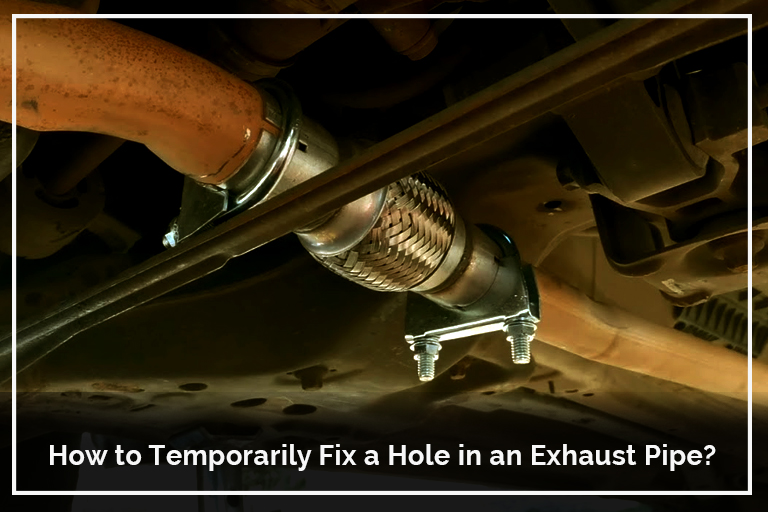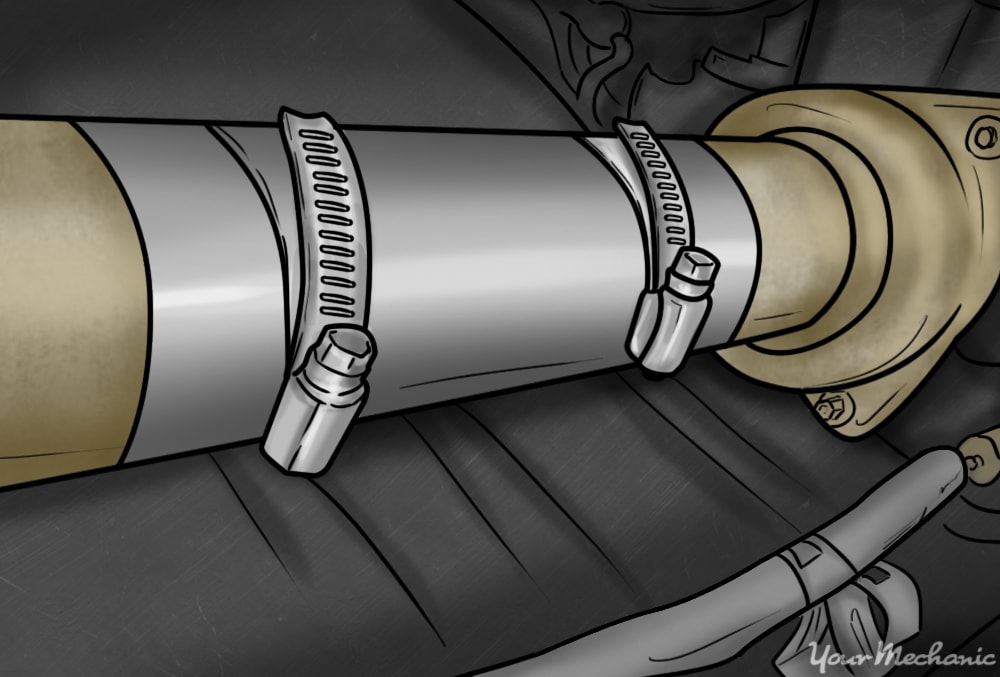Are you tired of the annoying noise and emissions coming from your car’s muffler? Is your muffler pipe suffering from a frustrating hole that’s causing all sorts of problems? Well, fret no more! In this guide, we will explore the step-by-step process of fixing a hole in your muffler pipe, allowing you to regain the peace and quiet you deserve while driving. Whether you’re a seasoned DIY enthusiast or a novice looking to save some money on costly repairs, this comprehensive tutorial will equip you with the knowledge and skills to tackle this common automotive issue. So, grab your tools, put on your work gloves, and let’s dive into the world of muffler pipe repair!
Picture this: you’re cruising down the road, enjoying the wind in your hair and the freedom of the open road. Suddenly, a strange noise interrupts your blissful journey, and you notice a decrease in your car’s performance. Chances are, a hole in your muffler pipe is to blame. While the thought of repairing it may seem daunting, fear not! With a little guidance and the right tools, you can fix this issue like a pro. In this comprehensive guide, we will break down the process into simple, easy-to-follow steps, ensuring that you can restore your muffler pipe to its former glory in no time. So, get ready to roll up your sleeves and embark on this DIY adventure. Your car will thank you, and you’ll be back on the road, enjoying the silence and efficiency you deserve.
How to Fix a Hole in a Muffler Pipe:
- Put on safety gloves and goggles.
- Clean the area around the hole with a wire brush.
- Apply a high-temperature epoxy or muffler patch to cover the hole.
- Let it dry according to the product instructions.
- Start the engine and check for any exhaust leaks.

Fixing a Hole in the Muffler Pipe: A Step-by-Step Guide
In this informative article, we will guide you through the process of fixing a hole in your muffler pipe. A damaged muffler pipe can lead to a decrease in performance, increased noise, and even potential safety hazards. By following these steps, you can repair the hole in your muffler pipe and restore optimal functioning to your vehicle.
Step 1: Safety Precautions
Prior to starting any repair work, it is important to take necessary safety precautions. Begin by parking your vehicle in a well-ventilated area, preferably outdoors, to avoid inhaling harmful fumes. Ensure that the engine is turned off and allow the muffler pipe to cool down completely. Wear protective gloves, safety goggles, and a face mask to safeguard yourself during the repair process.
Additionally, it is recommended to have a fire extinguisher nearby in case of any accidental fires. Adhering to these safety measures will help prevent any potential injuries or mishaps while repairing the hole in your muffler pipe.
Step 2: Assessing the Damage
The next step involves thoroughly inspecting the muffler pipe to assess the extent of the damage. Look for any visible holes, cracks, or areas of corrosion. It is important to have a clear understanding of the size and location of the hole before proceeding with the repair.
If the hole is small, less than an inch in diameter, it can often be fixed using a muffler repair kit. However, if the damage is extensive or the hole is larger than an inch, it may be necessary to replace the entire muffler pipe. In such cases, it is recommended to consult a professional mechanic for further assistance.
Step 3: Repairing the Hole
Once you have assessed the damage and determined that it can be repaired, it is time to fix the hole in the muffler pipe. Start by cleaning the surface around the hole using a wire brush to remove any rust or debris. This will ensure a better adhesion of the repair materials.
Next, apply the muffler repair paste or putty directly onto the hole. Use a putty knife or a gloved finger to spread the paste evenly over the damaged area, covering it completely. Make sure to follow the instructions provided with the repair kit for the best results.
Allow the repair paste to dry and cure according to the recommended time mentioned on the packaging. Once dry, the paste will harden, creating a seal over the hole, preventing any further leakage or damage. It is advisable to let the vehicle sit idle for a few hours to allow the repair to fully set before starting the engine.
Step 4: Final Checks
After completing the repair, it is essential to conduct a final inspection to ensure the hole is properly sealed. Examine the repaired area for any signs of remaining damage or potential leaks. If you notice any issues, consider seeking professional assistance or opting for a replacement muffler pipe.
Once you are satisfied with the repair, start the engine and listen for any abnormal noises or vibrations. Take a short test drive to ensure the muffler pipe is functioning correctly and there are no exhaust leaks.
Step 5: Maintenance and Prevention
To maintain the longevity of your repaired muffler pipe, it is important to practice good maintenance habits. Regularly inspect the pipe for signs of corrosion or damage, and address any issues promptly. Additionally, avoid driving over rough terrains or through deep water, as these can cause further damage to the muffler pipe.
Consider applying a heat-resistant coating to the muffler pipe to protect it from future corrosion and damage. This preventive measure can extend the lifespan of your muffler pipe and prevent the need for frequent repairs.
By following these step-by-step instructions, you can successfully fix a hole in your muffler pipe and ensure the optimal performance of your vehicle. Remember to always prioritize safety and consult a professional if you are unsure or uncomfortable with the repair process.
Frequently Asked Questions
In this section, we will address some common questions related to fixing a hole in a muffler pipe.
How can I identify a hole in my muffler pipe?
There are a few signs that can help you identify a hole in your muffler pipe. Firstly, you may notice a loud and unusual noise coming from your vehicle’s exhaust system. Additionally, you may observe a decrease in engine performance or experience a strong smell of exhaust fumes. Inspecting the muffler pipe visually can also help you spot any visible holes or cracks.
If you suspect a hole in your muffler pipe, it is recommended to have it inspected and repaired by a professional mechanic to ensure proper and safe functioning of your vehicle’s exhaust system.
Can I fix a hole in my muffler pipe by myself?
Fixing a hole in a muffler pipe requires specific tools and equipment, as well as a certain level of expertise. While small holes or cracks can sometimes be temporarily patched using muffler tape or sealant, this is not a permanent solution and may not effectively fix the issue.
It is generally recommended to have a professional mechanic assess and repair any holes or damage in your muffler pipe, as they have the necessary knowledge and tools to properly fix the problem, ensuring the longevity and efficiency of your exhaust system.
What is the cost of repairing a hole in a muffler pipe?
The cost of repairing a hole in a muffler pipe can vary depending on various factors such as the extent of the damage, the make and model of your vehicle, and the labor costs in your area. In general, the cost can range from $100 to $400 or more.
It is advisable to obtain quotes from different repair shops to compare prices and services offered. Additionally, it is essential to consider the reputation and expertise of the repair shop to ensure a reliable and quality repair.
How long does it take to fix a hole in a muffler pipe?
The time required to fix a hole in a muffler pipe can vary depending on the severity of the damage and the availability of replacement parts. In some cases, a small hole may be patched up relatively quickly, while larger holes or extensive damage may require more time.
It is best to consult with a professional mechanic to get an accurate estimate of the repair time. They will be able to assess the condition of your muffler pipe and provide you with a more precise timeframe for the repair.
What are the potential dangers of driving with a hole in a muffler pipe?
Driving with a hole in a muffler pipe can pose several risks. Firstly, the hole can cause a leak in the exhaust system, leading to the release of harmful gases such as carbon monoxide into the cabin of the vehicle. Carbon monoxide is odorless and can be extremely dangerous if inhaled in high concentrations.
In addition to the health risks, a hole in the muffler pipe can affect the overall performance of your vehicle. It can lead to decreased fuel efficiency, reduced engine power, and potential damage to other components of the exhaust system.
It is crucial to address any issues with your muffler pipe promptly and have them repaired to ensure your safety and the proper functioning of your vehicle.

In conclusion, it is evident that a hole in the muffler pipe can pose serious problems for a vehicle’s performance and overall functionality. However, with the right knowledge and a few simple steps, this issue can be easily resolved. By following the step-by-step guide provided in this article, one can save time and money by fixing the hole in the muffler pipe themselves, without the need for professional assistance.
Taking the necessary precautions and using the proper tools, such as a patch kit or a muffler repair tape, can ensure a successful repair. Additionally, regular maintenance and inspection of the muffler system can help identify any potential issues before they escalate. By addressing a hole in the muffler pipe promptly, drivers can not only restore their vehicle’s optimal performance but also contribute to a quieter and more environmentally friendly driving experience. Remember, with the right approach and a little DIY spirit, fixing a hole in a muffler pipe doesn’t have to be daunting – it can be a simple and rewarding task.
